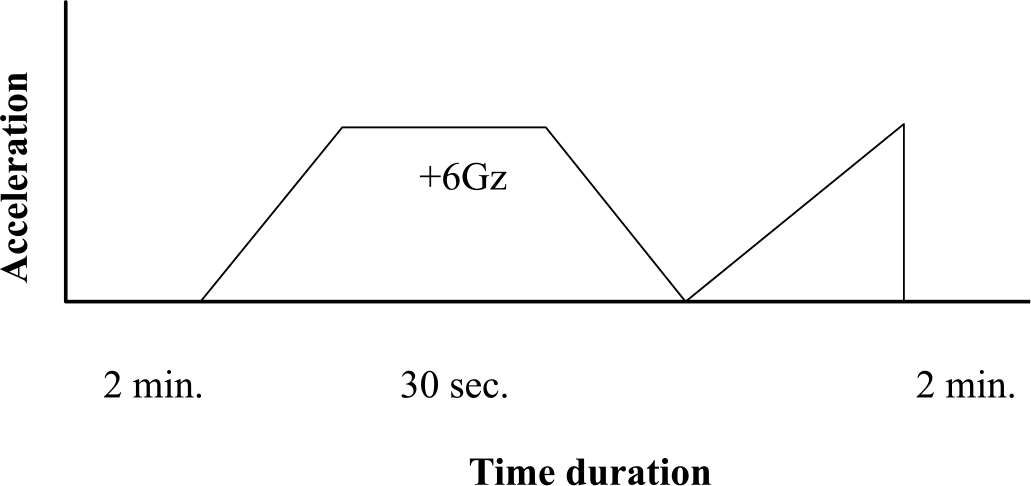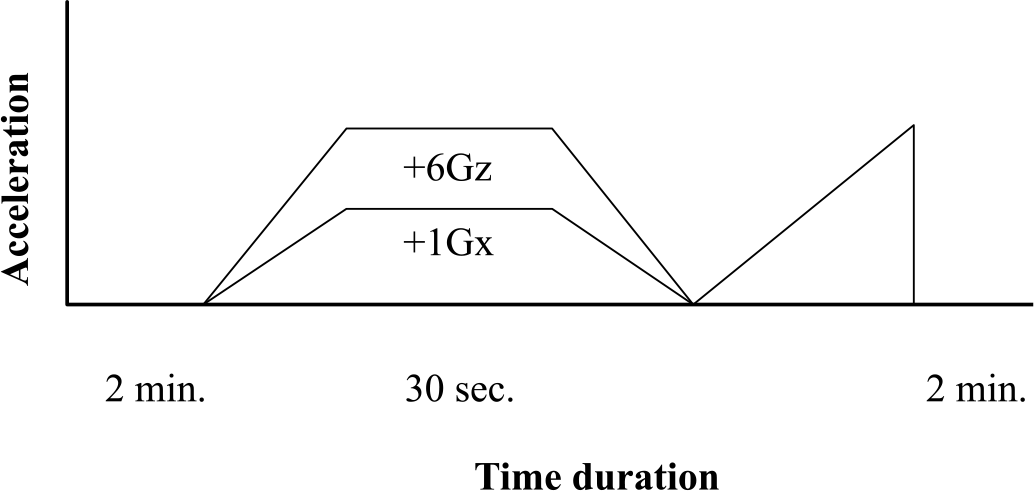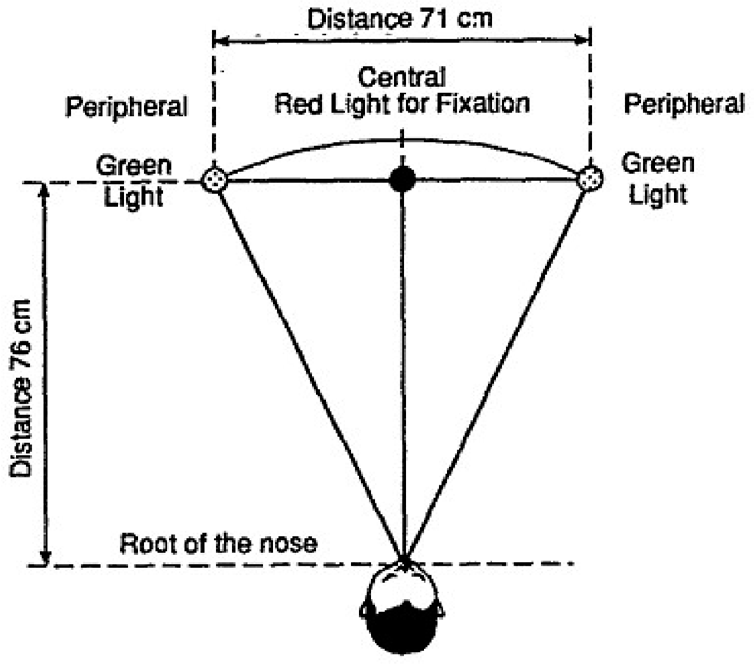Translate this page into:
Changes in Relaxed +Gz Tolerance following Exposure to Multiaxial Acceleration Stress (Gz & Gx)
Abstract
Background:
The modern day supermaneuverable aircraft are endowed with “Thrust vectored propulsion” (TVP) capabilities. The TVP together with “fly by wire” control system makes the aircraft highly agile, capable of maneuvering at high speeds and exposing pilots to multi axial acceleration stress which can alter their relaxed Gz tolerance. The present study was carried out to evaluate the effects of concurrent +Gx acceleration on relaxed +Gz tolerance.
Methods:
35 healthy male aircrew participated in the study. The study was done on High Performance Human Centrifuge (HPHC) at the Institute of Aerospace Medicine (IAM), IAF and comprised of two centrifuge profiles. The profile A was a pure +6Gz exposure for 30 seconds and profile B was a concurrent exposure of +1Gx acceleration along with +6Gz for 30 seconds. Both profiles were followed by assessment of relaxed +Gz tolerance in a gradual onset run (GOR) @ 0.1G/s with peripheral light loss (PLL) at 52-56 degree as the end point. The change in relaxed +Gz tolerance between the two profiles was analysed.
Results:
There was no significant change in the +Gz tolerance of aircrew on exposure to concurrent +Gx acceleration along with +6Gz stress for 30 sec.
Conclusion:
The addition of transverse acceleration of the magnitude of +1Gx to exposure to straining Rapid Onset Run upto +6Gz for 30 seconds , does not significantly alter relaxed +Gz tolerance afterwards
Keywords
Multiaxial acceleration
Gx acceleration
G tolerance
Introduction
The challenges which a pilot encounters during combat sorties include not only the ability to maintain high level of awareness and readiness at all times but also to execute both offensive and defensive actions as warranted by the situation. Advancement of technology has resulted in new “Supermaneuverable” aircraft being developed worldwide. By redirecting engine thrust in flight i.e. Thrust Vectored Propulsion (TVP), increased aircraft maneuverability can be achieved [1]. This TVP enhanced maneuvering has been termed variably as ‘Super Agility’ (SA), ‘Super Maneuverability’(SM) and ‘Enhanced Fighter Maneuverability’ (EFM) [2]. SM is defined as the ability to fly in the post-stall regime and refers to unusual flight trajectories [3].
Supermaneuverable aircraft can maneuver to produce sustained acceleration in X and Y axes, a situation to which pilots were not frequently exposed. During maneuvering this exposure to acceleration in X and Y axes may be followed by a sudden, rapid onset, sustained Gz stress. Multi-axis sustained accelerations experienced during thrust-vectored aircraft maneuvers, can either enhance or reduce the +Gz tolerance of the aircrew depending on the direction of the net gravitoinertial force [4]. Accelerations in the three axes have been studied individually. However, studies on the human consequences of these multi-axial accelerations are limited. The Post stall manoeuver reduces +Gz acceleration, but may increase Gx and Gy accelerations. A pilot’s performance could be affected if his physiological limitations are exceeded. Possession of Supermaneuverable aircraft by Indian Air Force (IAF) has necessitated research on these issues. Thus there is a need for exploring this uncharted territory, especially with supermaneuverable and thrust vectored aircraft becoming common [3]. The aim of this study was to see the change in relaxed +Gz tolerance of healthy IAF aircrew after exposure to combined (+Gx/+Gz) acceleration in a high performance human centrifuge (HPHC). It is hypothesised that the concurrent exposure of +Gx acceleration and +Gz acceleration would result in reduced +Gz tolerance.
Material and Methods
Subjects
A total of 35 healthy male volunteer fighter pilots participated in the study. An informed written consent was obtained from all the participants and the study protocol was duly approved by the Ethical Committee of the institute.
Equipment
The study was carried out in HPHC, a state of the art centrifuge, at the Department of Acceleration Physiology and Spatial Orientation, IAM, IAF, Bangalore. The HPHC is capable of generating multi axial as well as uni-axial G forces in any of the three axes and can be used for training in both open and closed loop. In training mode it can achieve a peak of 9Gz with 6G/sec max rate of onset. The cabin (gondola)consists of generic ejection seat, flight controls, basic instrument panel, anti G system and a light bar. The light bar has a central red light and two peripheral green lights placed on either side of the central red light subtending an angle of 52-56˚ to the eye. The control stick has a Dead Man Switch (DMS) and on releasing this switch, the centrifuge stops in open loop mode of training. The system has two way communications between cabin and control station and there is a facility to store multiple physiological parameters during the G run.
Study Protocol
The study comprised of two centrifuge runs (Profile ‘A’ & ‘B’) in open loop. The participants were advised to sit relaxed throughout the run and they wore a snuggly fitting anti-G suit to preclude total visual blackout or G-induced loss of consciousness. The details of the profiles are as follows:
Profile ‘A’ (Pure +Gz profile): A rapid onset open loop run @ of 1Gz/sec up to a peak of +6 Gz followed by sustained exposure of +6Gz for 30 sec. This was followed by deceleration to baseline (+1.4 Gz) @ 1G/s and again from baseline a gradual onset run (GOR) @ 0.1 G/sec till the visual endpoint of peripheral light loss (PLL) to assess the relaxed +G tolerance of the aircrew (Fig 1)

- Profile ‘A’
Profile ‘B’ (Multi axial Acceleration +Gz/+Gx profile): Profile B was similar to that of profile A with only difference being sustained exposure to concurrent +1Gx acceleration along with +6Gz stress. It was also followed by assessment of relaxed +G tolerance of the aircrew in the GOR run (Fig 2).

- Profile ‘B’
Visual End point: The PLL at 52 to 56º was taken as the visual endpoint for the study. During the profile, subjects were asked to focus on the light bar at a distance of 75 cm in front; the bar had central Red light and one peripheral Green light at either end (Fig 3). The subjects were instructed to remain relaxed and keep the DMS pressed throughout the GOR phase of profile and to concentrate on the central red light. Whenever the individual failed to see the green light he was advised to release the DMS, to terminate the run. The G level at which the peripheral green lights were no longer seen (PLL) was taken as the relaxed G tolerance of the participant. Central Light loss (CLL) or absolute black out was not attempted because of G-LOC concerns.

- Visual End Point System
Data Analysis
The data was retrieved from the HPHC on a compact disc and collated. The relaxed G tolerance of both the profiles was compared using paired t test. Results on continuous measurements are presented as Mean ±SD (Min-Max). Significance is assessed at 0.05 level.
Results
A total of 35 participants took part in the study but the relaxed G tolerance for both the profiles ‘A’ and ‘B’ could be measured for only 30 participants as 5 participants left the DMS inadvertently during the profile and hence their data was discarded. The anthropometric details of all the participants were recorded; the mean age of the participants was 27.67±4.1 years, weight was 74.3± 8.02 kg and height was 174.6 ± 5.58 cms.
Relaxed +Gz Tolerance: The mean relaxed +Gz tolerance recorded in Profile A and B was 5.91±0.74 and 5.85±0.62 (Mean±SD) respectively. There was a decrease in mean relaxed +Gz tolerance in profile B as compared to profile A. However, the change was not statistically significant (p=0.580). The comparative analysis between the two profiles is presented in Table no. 1
| G tolerance | Profile A | Profile B | Difference between Profile A & B | t value | P value |
|---|---|---|---|---|---|
| Min-Max | 3.82-7.47 | 4.59-7.57 | - | - | - |
| Mean ±SD | 5.91±0.74 | 5.85±0.62 | 0.062 | 0.560 | 0.580 |
Discussion
To simulate a realistic scenario as experienced by aircrew during flying an ASF/SM fighter aircraft, a multiaxial acceleration profile of +1Gx/+6Gz for 30 seconds was selected in the present study based on the findings of study done by Tripathy et al [5]. The relaxed G tolerance was measured immediately after exposure to multiaxial acceleration (Profile B). In order to have comparable baseline, the relaxed G tolerance was also measured after a pure +6Gz run (Profile A) of same duration. Since the participants were exposed to HSG (>+6Gz for 15s), they were made to wear a snuggly fitting Anti-G suit (AGS) as a safety measure. AGS might have increased the G tolerance but the affect was nullified by using same AGS in both the profiles. Both profiles were conducted in an open loop where the rate of onset and offset of the acceleration was predefined (automated) and not actually controlled by the aircrew. However, the participants had the control to terminate the run at any point by using Dead Man Switch (DMS). There was adequate rest period between the exposures so as to allow the subjects’ heart rate to return to baseline levels.
The relaxed +Gz tolerance on exposure from chest to back (+Gx) sustained acceleration in addition to head to toe (+Gz) acceleration resulted in no statistically significant change as compared to relaxed +Gz tolerance in the pure +Gz exposure. However, a decreasing trend was noticed during the multiaxial run as compared to pure +Gz run. Similar results were also seen in a study by Albery where he studied the effect of multi-axial acceleration on +Gz tolerance in Dynamic Environment Simulator (DES). It was found that adding moderate (+2.5Gx) transverse acceleration significantly reduced the G tolerance (up to 0.27 +Gz) and addition of moderate lateral Gy acceleration significantly increased +Gz tolerance (up to 0.60 Gz during 2 Gy) in relaxed, unprotected centrifuge participants [4]. In the present study, the participants were exposed to HSG while Albery exposed the participants to variable levels of Gx and Gy acceleration and measured the G tolerance in GOR run without AGS. The use of AGS, different onset rates, lower values of +Gx level and participants performing Anti-G Straining Maneuver (AGSM) during the high G exposure and continuing straining during the GOR phase may have contributed to the variation in the results of the current study.
The transverse acceleration tend to press the participant against the seat, making breathing difficult and thus there was a possibility that participants would have continued to strain even during the GOR phase leading to increase in the G tolerance. But exposure of only +1Gx is very unlikely to cause breathing difficulties (usually noted at +3Gx). Though the participants were instructed to sit relaxed during GOR run but were not monitored for straining (via electromyography) and only observed via live video streaming at the control station.
The literature worldwide on multiaxial acceleration is sparse. A study on similar lines was conducted at IAM, IAF with an objective of studying effects of lateral acceleration (Gy) on +G tolerance by Goel et al [6]. There was a mean increase in G tolerance of 0.61 Gz during the combined acceleration run as compared to pure Gz run. The combined acceleration run led to a better cardiovascular response which may have accounted for the increased tolerance. Another study was undertaken by Rajurkar et al [7] to observe the physiological parameters during combination of various accelerations and Tri-axial acceleration and concluded that addition of other axes acceleration including triaxial acceleration which are likely to be encountered in SM and SA aircraft, does not pose any additional stress or strain on cardio-respiratory system.
The recording of physiological parameters like HR and BP during similar studies might give better quantification of the physiological stress and comparative assessment for objective analysis. Further studies with recording of physiological parameters are recommended.
Aeromedical Significance
No significant change in relaxed +Gz tolerance was found on exposure to multiaxial acceleration of similar magnitude in terms of +Gz. The presence of concurrent +1Gx acceleration, which is usually encountered during combat and aerobatic flying did not lead to decrement in performance and increased vulnerability to G-induced Loss of Consciousness (G-LOC) as the relaxed G tolerance was not significantly affected by the concurrent +1Gx exposure.
Hence, from results of the study it can be inferred that the addition of +1Gx acceleration does not impose a significant additional stress to the pilot and the effects are similar to that of exposure to uniaxial +Gz acceleration.
Conclusion
The present study was undertaken to observe the effect of +Gx acceleration on +Gz tolerance with a profile representative of a multiaxial profile in a super maneuverable aircraft. A decreasing trend of +G tolerance was noticed during the multiaxial run as compared to pure +Gz run, however it was not statistically significant. The present study has shown that the addition of transverse acceleration of the magnitude of +1Gx to exposure of straining rapid onset run upto +6Gz for 30 seconds does not significantly alter relaxed +Gz tolerance afterwards.
References
- Human consequence of agile flight In: NATO RTO working group. 2001. Final technical report: TR-015
- [Google Scholar]
- Acceleration in other axes affects +Gz tolerance: Dynamic centrifuge simulation of agile flight. Aviat Space Environ Med. 2004;75(1):1-6.
- [Google Scholar]
- Effects of coriolis reaction on respiration and blood-flow changes in man. Aviation Med. 1968;39:837-844.
- [Google Scholar]
- Analysis of multi-axis acceleration profile in a supermaneuverable aircraft. Ind J Aerospace Med. 2006;50(2):7-12.
- [Google Scholar]
- Effect of + Gy acceleration on +Gz tolerance [dissertation] In: Rajiv Gandhi University of Health Sciences. 2011.
- [Google Scholar]
- To study the physiological parameters during complex multiaxial acceleration exposure simulation in a human centrifuge [dissertation] In: Rajiv Gandhi University of Health Sciences. 2013.
- [Google Scholar]






